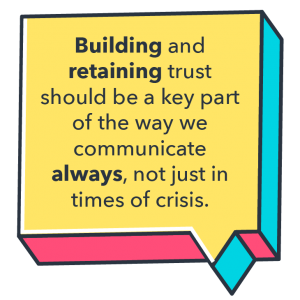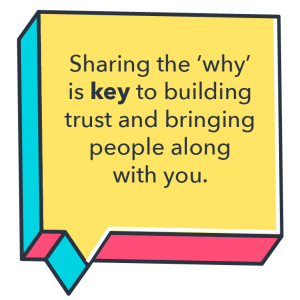How to bust the myths and ensure employees do the right thing.
Fake news remains as rife as ever. Over the last few months, we’ve seen everything from conspiracy theories about 5G masts through to recent unfounded reports of hand sanitiser combusting when left in hot vehicles.
And back in January …
“the 2020 Edelman Trust Barometer revealed that despite a strong global economy and near full employment, none of the four societal institutions that the study measures—government, business, NGOs and media—is trusted.”
This toxic combination of fake news and low levels of trust have resulted in worrying scenes of people descending on beaches in their thousands, ignoring social distancing advice set out by the government. And you could argue why wouldn’t they, when they no longer know who or what to believe.
However, a further piece of research conducted by Edelman in March 2020 found that after health authorities, employers were most trusted to respond effectively to the pandemic.
This is hugely encouraging, especially as employees begin to return to their places of work. It’s never been more important that people follow the measures we put in place for their safety and trust that the advice their employers are giving is right.
The consequences of non-compliance could be not only be disastrous for the health of our employees but the viability of the businesses we work for. One confirmed case of Covid-19 could result in a whole team having to self-isolate – far from ideal if your employees aren’t able to do their jobs from home.
So, as internal communicators, how do we ensure that our messaging is understood and trusted against a backdrop of fake news and conspiracy theories?
Create a single source of truth
Many internal communications teams have been doing this since lockdown began – creating the one place that employees know contains up to date, accurate information. Identify which of your channels are the most trusted and ensure that as employees return to their places of work, they have access to this, and it’s updated regularly.
It’s also important to ensure there’s alignment. Leaders and managers need to be aware of the key messages and reiterate them, being careful to not contradict or confuse their teams. They also need to be conscious of sharing any external sources that haven’t been fact checked or responding to questions if they’re not sure of the correct answer. And remember, where different countries have different guidelines communication will need to be localised – often one message will not be suitable for all.
However, a single source of truth will only work during a situation like the one we currently find ourselves in if employees already trust the communications they receive/have access to. Creating a dedicated site or having a chosen spokesperson is all well and good but if trust was already lacking inside your organisation, that won’t change overnight.
Building and retaining trust should be a key part of the way we communicate always, not just in times of crisis.
Have empathy
Employees are more likely to trust that organisations are fully prepared for their return to the workplace and that the communication they receive is accurate, if they feel understood. This means showing empathy when communicating, remembering that while we’ve all lived through this pandemic, individual experiences of it are very different.
Hopefully your leaders have been visible throughout the last few months and it’s important this continues as we begin to move towards a new ‘normal’. Not only will people want to hear from them, but they’ll want to see them walking the walk too.
Encourage leaders to acknowledge that people may have differing feelings about coming back. Some will have concerns about their own health, be grieving for loved ones or still trying to manage home schooling, whereas others might be eager to return, having spent much of lockdown on their own or in challenging circumstances (or they just don’t like homeworking). Leaders can also share their own experiences and what they’ve found challenging, making them more relatable and trustworthy.
Share the why
It’s important to remember that return to workplace conversations have been going on for some time with key stakeholder groups but employees won’t have been party to these. Don’t just communicate what will happen but why those decisions have been made to help employees trust that they are the right decisions.
For example, certain decisions may have been mandated by government or been made to factor in the way some employees need to work to do their jobs effectively.
Provide as much information as you can as soon as you have it, while keeping it clear and simple, about how the process will work and be willing to take on feedback and consider individual circumstances.
Sharing the ‘why’ is key to building trust and bringing people along with you.
Share stories
If you’re having a phased return to your workplaces, tell stories from some of the first people back. This will help others begin to visualise what it will be like and trust that the right decisions have been made and the correct precautions are in place.
Remember to share some of the challenges and what’s been learnt from going through the process and how you’ve adapted based on feedback. This will ensure the stories are authentic and more likely to be trusted.
As much as people want to hear from leadership, they are also more likely to trust people like them who are doing similar roles or working in similar environments. In his book Inside the Nudge Unit, David Halpern talks about the EAST model, a framework created to help people apply nudge theory. The Social element of the model talks about how we are very influenced by those around us.
For example, even if we know wearing a mask is a good thing to do, if no one else is, we’re less likely to do it. That’s why storytelling can be so powerful in encouraging the right behaviours by demonstrating others following good practice.

The next few weeks and months will be critical for business as we begin to get used to our new reality. Internal communicators have a big role to play in maintaining trust and ensuring that employees are not only informed but demonstrate the right behaviours.
And to be clear, they have a role to play, not the role. As always internal comms is integral, but the overall success will be the cumulation of cross team collaboration and recognition of the value each department brings. So, let’s ensure that our colleagues are in no doubt about the impact internal communication has on an organisation, particularly during a crisis.
By Helen Deverell for Alive with Ideas
Further reading
Want to read more about Nudge? Have a look at our infographic on the EAST framework.
















